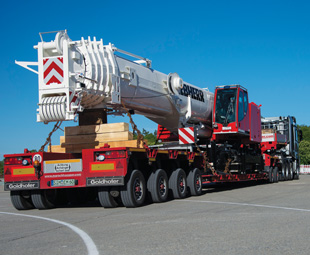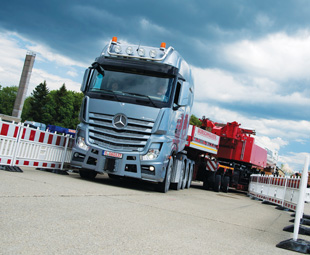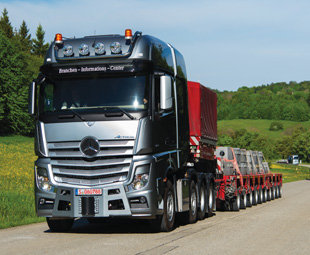Going BIG!

I recently jumped at the chance to attend the world launch of the Mercedes-Benz SLT, the heavyweight star of that particular trucking family. Little did I know what lay ahead …
You probably haven’t heard of Münsingen. A month or so ago, neither had I. Basically it’s a sweet little Swabian town, which is home to a massive testing ground established by the then German Empire, back in 1895. Initially it was used for military testing; today it’s used by Mercedes-Benz to test its trucks.
That, of course, is the reason why I am here; seated in what used to be a barrack, bracing myself for the drive of a lifetime in the SLT, which, it has to be said, is the mother of all trucks. It can transport up to 250 t. In other words, you could theoretically load it with around 300 smart cars. If all of these cars were lined up one after the other, they would extend back more than 800 m …
For extreme assignments, it’s possible to harness together up to three SLT tractors, one of which would be specially reinforced. Together, these vehicles can even manage a total towing weight of 750 t – the equivalent of a fully fuelled, launch-ready Ariane 5 booster rocket from Airbus!
Today we’re not doing that. (Whew.) We’re testing Actros and Arocs derivatives with a total weight of a mere 170 t. My German hosts seem dubious about my ability to drive these trucks. Truth be told, so am I, but I haven’t mentioned this to the Germans – just to a delightful Irish journalist, who tells me not to stress. “Just imagine that you’re driving a Sprinter,” he advises. I am not sure if it’s his calm demeanour, sweet smile or Irish lilt, but I calm down to a mild panic.
Fortunately, the day begins in non-dramatic fashion – with a lecture. I worry that my rapidly-beating heart will drown out the sound of the lecturer, who does a sensational job of telling us all about one of the truly special features of the Mercedes-Benz Actros and Arocs SLT, namely the turbo retarder clutch.
Essentially, the turbo clutch acts as a hydraulic coupling between the engine and the transmission. It fills with oil when full power is required, generally on take-off, or at low speed when loaded, and disengages when enough momentum is achieved for the transmission to change up out of first gear. From then on the dry friction plate clutch takes over and the turbo clutch drains of oil and essentially locks out. The turbo retarder clutch also puts a good 80 kg less on the scales than a comparable torque converter clutch, making for a commensurately higher payload. It’s a Seriously Clever Thing.
 Then it’s time to put this Seriously Clever Thing – plus the rest of the ensemble – to the test. First up is an Arocs tipper – the 4145 8×4 – with a gross vehicle mass (GVM) of 41 t, which I’m going to drive around a demanding off-road track. I am accompanied by a cheerful German instructor who speaks absolutely no English. Luckily, with my pigeon German and some “aus, aus”, I manage to boot him out of the driver’s seat (the poor fellow’s eyes widen when he realises I intend driving).
Then it’s time to put this Seriously Clever Thing – plus the rest of the ensemble – to the test. First up is an Arocs tipper – the 4145 8×4 – with a gross vehicle mass (GVM) of 41 t, which I’m going to drive around a demanding off-road track. I am accompanied by a cheerful German instructor who speaks absolutely no English. Luckily, with my pigeon German and some “aus, aus”, I manage to boot him out of the driver’s seat (the poor fellow’s eyes widen when he realises I intend driving).
Incidentally, the nomenclature means that 41 t of Arocs and gravel are matched against a 330 kW (450 hp) engine, which happens to be coupled to the fully automatic PowerShift version of the 16-speed G 280-16 transmission.
Before we kick off, the instructor draws my attention to a small indicator light that will show what the turbo retarder clutch is up to. I cannot help but giggle. I won’t be looking at lights. I will be clinging onto the steering wheel for dear life …
Then we’re off – well, almost. I engage drive, but the Arocs doesn’t move. After all, the turbo clutch is not a torque converter, meaning the truck won’t creep forward. I apply a tiny bit of pressure to the accelerator, the turbo clutch fills with oil, and power is transferred from the engine to the transmission. We’re off! The automatic gearbox changes ever so smoothly and soon the friction clutch takes over loss-free power transfer.
We approach a 27o gradient and the instructor indicates that I should slow down and then stop – halfway up the hill. I think he’s gone raving mad. It’s a stupid thing to do. I’m convinced he’s loony (or something’s lost in translation), when he suggests I let the tipper roll back. I do so – reluctantly, hearing myself yelp as I perform this stupid thing. A furtive glance at the instructor shows he’s totally relaxed. I see why. He indicates that I can end my free-fall, accelerate and proceed to the top of the hill. The tipper does so in gentlemanly fashion. In fact, it’s all completely effortless …
 Now I am full of bravado. So, when I am entrusted with the biggest and most powerful of all series-produced Mercedes-Benz Actros and Arocs trucks – the 4163 LS 8×4 SLT with the new Euro-6, 15,6-litre, six-cylinder in-line engine, generating 460 kW (625 hp) of power and 3 000 Nm of torque – I am totally chilled. Yes, it’s a hugely imposing sight: total weight 170 t, total length 21 m, but hey, I am relaxed. I am just driving a Sprinter – remember?
Now I am full of bravado. So, when I am entrusted with the biggest and most powerful of all series-produced Mercedes-Benz Actros and Arocs trucks – the 4163 LS 8×4 SLT with the new Euro-6, 15,6-litre, six-cylinder in-line engine, generating 460 kW (625 hp) of power and 3 000 Nm of torque – I am totally chilled. Yes, it’s a hugely imposing sight: total weight 170 t, total length 21 m, but hey, I am relaxed. I am just driving a Sprinter – remember?
Actually, it’s just like driving a normal Actros. I pop the G 280-16 16-speed constant-mesh transmission, with Mercedes PowerShift 3, into drive and we’re off. This time, I actually take the time to study the light that demonstrates the turbo retarder clutch’s tricks. It illuminates only briefly – the all-hydraulic start-off phase is already over and the tried-and-tested mechanical duo of single-plate dry clutch and PowerShift transmission takes over sole responsibility for torque transfer.
This time around, my instructor speaks excellent English and so we have a lekker chat as we move our 170 t around the Panzer-Ring-Strasse. We also have a giggle or two – at one stage, my fuel consumption is 298 l/100 km. “Never mind,” he jokes. “I won’t be sending you a bill for the fuel.”
I just love the whole experience, even taking time out to enjoy the beautiful scenery. The vehicle is as manoeuvrable as a Sprinter, and I have to remind myself of my enormous trailer from time to time by checking the mirrors.
Of course, 170 t is not to be messed with, so I am constantly mindful of my speed, especially when going downhill, but this is ever so easy to manage. Using the limiter function of the speed control regulator, I key in a maximum speed of 20 km/h, and we move downhill at 1 500 r/min – no problem! At other times, I rely exclusively on the engine brake, which does a dandy job.
 Next, my instructor tells me to do a repeat performance of the tipper: stop on a hill and let the truck roll back. This time I ask him if he’s nuts. He laughs. “It’s not a problem. Really. Yes, I know that if this were a vehicle with a conventional friction clutch, our journey would end and we’d be facing a repair bill of at least €10 000. Conversely, a vehicle with a torque converter would give up the ghost on account of overheating – but we will be fine. Trust me,” he says.
Next, my instructor tells me to do a repeat performance of the tipper: stop on a hill and let the truck roll back. This time I ask him if he’s nuts. He laughs. “It’s not a problem. Really. Yes, I know that if this were a vehicle with a conventional friction clutch, our journey would end and we’d be facing a repair bill of at least €10 000. Conversely, a vehicle with a torque converter would give up the ghost on account of overheating – but we will be fine. Trust me,” he says.
He’s right. We do this over and over again. It’s just incredible. It’s practically impossible to mess it up. Next up, we do the same thing – but he activates the crawl function with integrated manoeuvring mode (yet another of the truck’s clever features). When I release the brake, the 170 t SLT immediately creeps forward and now needs reining back with the service brake. This is something that will be familiar to many drivers who used to drive trucks with torque converter clutches.
At the end of the test drive I tell my instructor that I am going to give up journalism and go drive abnormal loads in Germany, but then he mentions the deal killer to me. These trucks are only allowed on the road after 22:00. Starting work at 22:00 each night? I don’t think so. Not even for the privilege of commandeering an SLT …
Published by
Focus on Transport
focusmagsa




 Big news from FOCUS on Transport + Logist
Big news from FOCUS on Transport + Logist


 !
Starting 1 April, every
!
Starting 1 April, every


 FUSO: Driving the Future of Mobile Healthc
FUSO: Driving the Future of Mobile Healthc



 A brand
A brand




 Wondering about the maximum legal load for a
Wondering about the maximum legal load for a 
 The MAN hTGX powered by a hydrogen combus
The MAN hTGX powered by a hydrogen combus

 Exciting News for South African Operators
Exciting News for South African Operators


